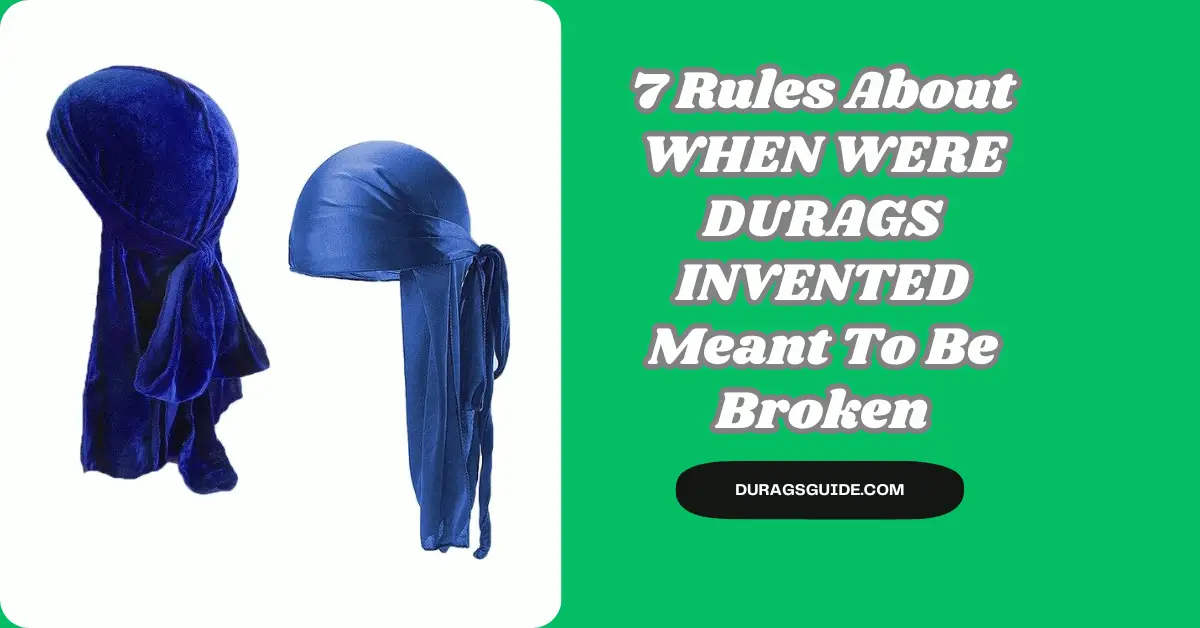Introduction: The Persona of Durags
Durags are something other than headwear; they are an image of culture, personality, and style. Frequently misjudged, their set of experiences is rich and multi-layered. This article will challenge seven normal convictions about the innovation and utilization of durags. By investigating these “rules” intended to be broken, we uncover the genuine quintessence and persevering through meaning of durags. Jump into find the astonishing beginnings, various applications, and the social effect of this notorious frill.
Verifiable Starting points of Durags
Durags, frequently seen as a cutting edge style embellishment, have well established starting points that length hundreds of years. Their excursion from commonsense headwear to social image is a captivating story.
Early Purposes and Social Beginnings
The earliest types of durags can be followed back to old African developments. In these networks, headwraps were normally used to safeguard hair from the brutal sun and to keep it clean. These headwraps, produced using different textures, were antecedents to the cutting edge durag. They were viable as well as conveyed critical social and social implications, frequently showing one’s status, identity, or job inside the local area.
During the nineteenth 100 years, especially in the US, the utilization of headwraps advanced. Oppressed African Americans utilized them to keep up with their hair and safeguard it while working extended periods of time in the fields. These headwraps were both a need and an unpretentious demonstration of opposition, protecting their legacy and personality even with mistreatment.
Development of Durags Through Various Times
The twentieth century checked massive changes in the utilization and view of durags. During the 1930s, during the Harlem Renaissance, durags turned into an unmistakable installation inside African American people group. This period was a social recovery where craftsmanship, music, and style prospered, and durags started to represent an association with African legacy and a declaration of dark personality.
During the 1960s and 1970s, durags acquired further unmistakable quality. The Dark Power development saw activists and pioneers wearing durags as a proclamation of pride and rebellion against racial separation. They were an image of fortitude and a visual portrayal of the battle for social liberties and balance.
The 1990s and mid 2000s saw durags enter standard design, generally on account of hip-bounce culture. Specialists like Tupac Shakur and 50 Penny promoted the durag, making it a staple in metropolitan style. It was at this point not simply a practical thing yet a design proclamation and a social symbol.
Today, durags keep on developing. They are seen on design runways, in music recordings, and as regular wear. They have risen above their unique reason, turning into a flexible extra worn by individuals of different foundations for various reasons. The cutting edge durag is a mix of usefulness, design, and social legacy, continually adjusting to recent fads and styles.
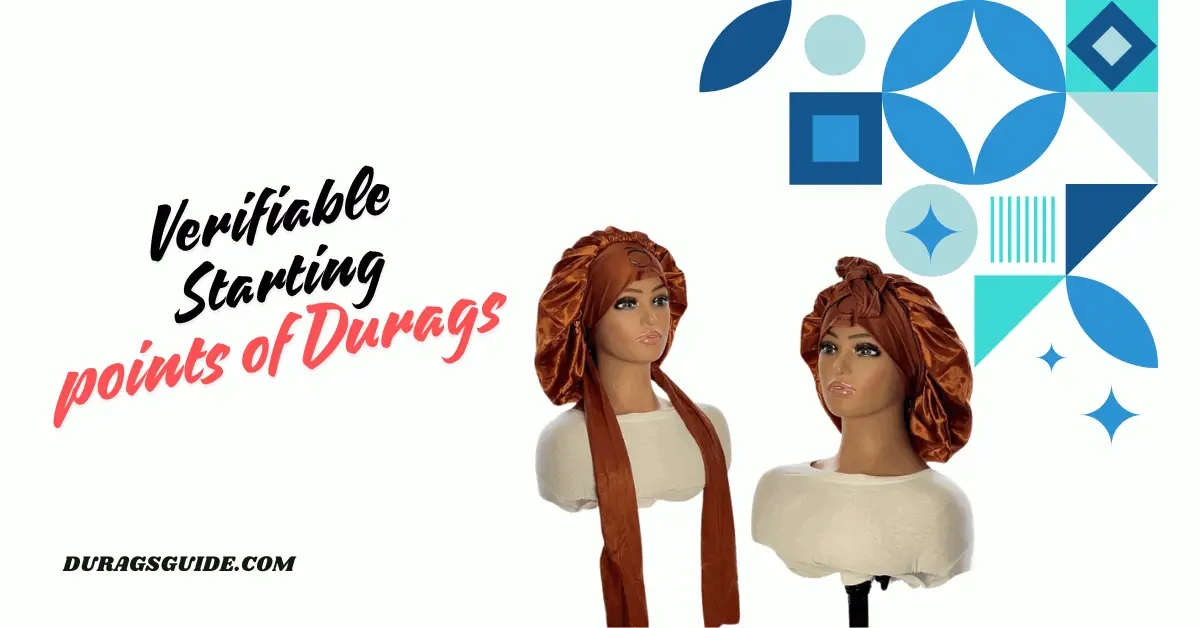
7 Rules About WHEN WERE DURAGS INVENTED
| Rule | Description |
| 1 | Historical Context: Durags originated in the 19th century, linked to African American history and culture. |
| 2 | Early Uses: Initially used by African American laborers and slaves to maintain hairstyles and protect hair from environmental damage. |
| 3 | Evolution: The style and usage of durags evolved over the decades, especially during the Harlem Renaissance in the 1920s. |
| 4 | Cultural Significance: Became a symbol of identity and pride within the African American community, representing resilience and cultural heritage. |
| 5 | Mainstream Adoption: Gained popularity in mainstream culture during the 1990s and 2000s, influenced by hip-hop and R&B artists. |
| 6 | Modern Usage: Today, durags are used for various purposes, including fashion, hair care, and cultural expression. |
| 7 | Material Advancements: Originally made from simple fabrics, modern durags are now crafted from silk, velvet, and other materials for improved functionality and style. |
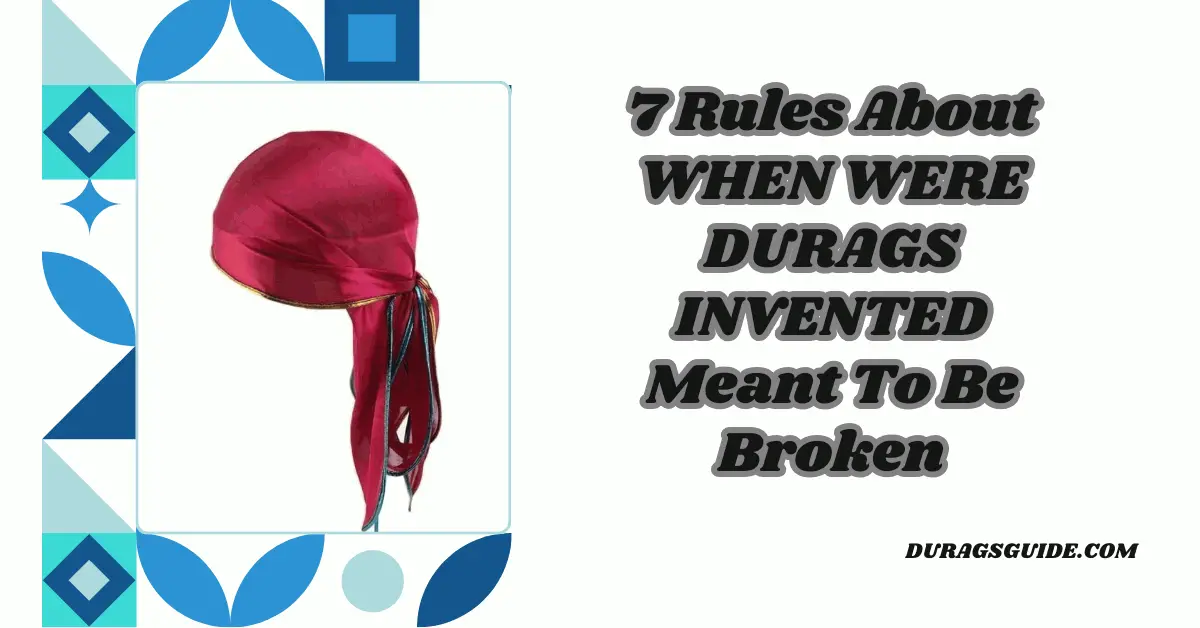
Rule #1: Durags Were developed As of late
A typical misinterpretation is that durags are a new development, arising essentially in the late twentieth hundred years. Nonetheless, the historical backdrop of durag-like headwear goes back a lot further, uncovering a rich embroidery of social importance and utility that traverses hundreds of years.
Exposing the Misinterpretation about Late Innovation
While durags, as we probably are aware them today, turned out to be generally perceived during the 1990s and 2000s, their underlying foundations are old. Head covers like durags have been utilized for millennia across different societies. In antiquated Egypt, for instance, all kinds of people wore headwraps to shield their hair from the cruel desert sun and sand. These headwraps, frequently produced using cloth, filled both viable and representative needs, similar as current durags.
During the Transoceanic Slave Exchange, African slaves carried their practices and customs to the Americas, including the utilization of headwraps. Oppressed Africans utilized these wraps to keep up with their hair and as a type of quiet obstruction, safeguarding a piece of their social personality in an unfamiliar land. This training laid the basis for what might ultimately develop into the durag.
Proof of Durag-Like Headwear in Antiquated Times
Verifiable records and antiquities give adequate proof of head covers looking like durags all through different antiquated civic establishments. In numerous African societies, headwraps were reasonable as well as an indication of economic wellbeing and otherworldly convictions. They were frequently complicatedly tied and styled, showing one’s local area, conjugal status, or occupation.
In old Mesopotamia, head covers were worn by various classes, including eminence and normal people, to imply rank and association. Also, in antiquated China and India, headwraps and turbans filled in as significant social images, demonstrating everything from societal position to strict commitment.
The development of these headwraps into what we currently perceive as durags can be followed through the African diaspora, particularly in the Americas. In the nineteenth hundred years, during and after the time of bondage in the US, African Americans proceeded with the custom of wearing headwraps. These headwraps step by step changed into the durag, adjusting to new materials and styles however holding their center motivation behind hair assurance and social articulation.
In the mid twentieth hundred years, durags started to be made and promoted explicitly for hair care. At first called “hair nets” or “straps,” these early durags were intended to secure and style African American hair, especially for keeping up with waves and meshes. After some time, they turned out to be all the more well known as durags, a term that probably gets from “do-cloth” or “du-cloth,” another way to say “haircut cloth.”
Today, while the cutting edge durag has turned into an unmistakable style frill, its verifiable heredity dissipates its legend being a new creation. The utilization of head covers like durags ranges hundreds of years and mainlands, mirroring a profound and various legacy. Understanding this set of experiences permits us to appreciate the durag as a contemporary style decision as well as a continuation of a well established social practice.

Rule #2: Durags Are Just for Hair Upkeep
One of the most inescapable fantasies about durags is that they are exclusively practical things utilized for hair support. While the facts confirm that durags assume a fundamental part in safeguarding and styling hair, their importance reaches out a long ways past this solitary reason. Durags are a strong image of personality, culture, and style, woven into the texture of different networks.
Investigating the Assorted Motivations behind Durags Past Hair Care
Durags are basically known for their capacity to assist with keeping up with hairdos, especially waves, meshes, and twists. By getting hair and decreasing grating, durags assist with watching out for styles, forestall breakage, and keep up with dampness. This commonsense capability has made them a staple in hair care schedules, particularly inside African American people group.
Be that as it may, restricting the job of durags to hair upkeep neglects their more extensive social and emblematic significance. Durags have for quite some time been utilized as a type of self-articulation and social pride. They act as an association with African legacy and a method for declaring character despite cultural tensions to adjust to various magnificence guidelines.
Durags are additionally worn for security against the components. In sweltering environments, they safeguard the scalp from the sun, while in chilly climate, they give warmth. This down to earth perspective is a continuation of their verifiable use in different societies where head covers were fundamental for safeguarding against brutal ecological circumstances.
Design, Character, and Social Proclamation
Durags have risen above their practical beginnings to turn out to be strong design explanations. Throughout the long term, they have been embraced by different subcultures, most strikingly inside the hip-bounce local area. Specialists like Tupac Shakur, Nelly, and Jay-Z have advocated durags, wearing them in music recordings, in front of an audience, and in open appearances. This perceivability has solidified the durag’s status as an image of metropolitan style and social character.
The style world has additionally observed, with top of the line planners consolidating durags into their assortments. This standard acknowledgment has featured the durag’s flexibility and tasteful allure, changing it into an in vogue embellishment worn by individuals from different foundations.
Besides, durags have turned into a material for innovativeness. They come in different varieties, examples, and materials, permitting wearers to communicate their own style. Customization choices, like weaving and embellishments, play additionally extended their part as a style frill.
The social assertion made by wearing a durag goes past simple style. For some, it is a demonstration of recovering and commending their legacy. In social orders where dark hair is frequently politicized and exposed to examination, wearing a durag is a striking declaration of social pride and opposition. It challenges excellence standards and commends the uniqueness of dark hair.
Furthermore, durags have tracked down a spot in friendly and political developments. They are worn as images of fortitude and obstruction, similar as they were during the Social equality Development. Current developments, for example, People of color Matter have seen activists wearing durags to represent solidarity and insubordination against racial unfairness.

Rule #3: Just Men Wear Durags
A predominant misguided judgment is that durags are solely for men. This generalization disregards the verifiable and contemporary utilization of durags by ladies, who have worn them for both pragmatic and expressive purposes. Understanding the different utilization of durags across sexes gives a more extravagant, more comprehensive image of their importance.
Authentic and Contemporary Instances of Ladies Wearing Durags
By and large, ladies have used head covers like durags because of multiple factors. In numerous African societies, headwraps were normal for all kinds of people. These headwraps were utilized for safeguarding hair, keeping up with hairdos, and conveying social or conjugal status. Ladies, specifically, wore them as a type of unobtrusiveness and social articulation.
In the African American people group, ladies have long utilized durags and comparable head covers to safeguard their hair. During subjection, headwraps filled in as a pivotal device for ladies to deal with their hair while working extended periods. This custom proceeded with post-liberation, developing into the utilization of durags as a way to keep up with many-sided haircuts like interlaces and twists.
Contemporary models further represent the job of durags among ladies. Today, numerous ladies wear durags to protect their hairdos short-term, guaranteeing that twists, waves, and normal twists stay in salvageable shape and without frizz. The normal hair development has likewise seen a resurgence in the utilization of durags as ladies embrace their regular hair surfaces and look for defensive styling choices.
VIPs and well known people play had a huge impact in testing the idea that durags are exclusively for men. Powerful ladies in the music, style, and media outlets frequently wear durags as both a reasonable extra and a design proclamation. Specialists like Rihanna and Solange have been seen wearing durags, carrying them into the standard and featuring their flexibility and interest for ladies.
Orientation Inclusivity in Durag Culture
Durags are innately orientation comprehensive, filling in as viable and chic things for anybody paying little heed to orientation. The possibility that durags are orientation explicit is a restricted view that neglects to perceive their all inclusive allure and usefulness. As social images, they rise above orientation, offering a method for self-articulation and character for all.
Style has progressively embraced this inclusivity. Originators make durags in various styles, varieties, and materials that enticement for everybody. This shift reflects more extensive changes in style, where impartial and comprehensive plans are turning into the standard. Durags are presently promoted and intended for all sexes, empowering a more comprehensive way to deal with this notable embellishment.
The comprehensive idea of durags additionally reaches out to their job in friendly and social developments. Ladies wearing durags frequently offer strong expressions about their character, legacy, and protection from cultural standards. For example, in developments pushing for regular hair acknowledgment, durags act as an image of strengthening and social pride.
Also, online networks and web-based entertainment have given stages to ladies to share their encounters and styles including durags. Instructional exercises, style tips, and individual stories feature how ladies use durags in their regular routines, further normalizing and commending their utilization across sexual orientations.

Rule #4: Durags Are Well defined for African American Culture
Durags are much of the time seen as a quintessential component of African American culture, which is without a doubt a focal part of their character. In any case, the thought that durags are elite to African American culture disregards their more extensive verifiable setting and multifaceted importance. The impact and reception of durags reach out past any single social gathering.
Worldwide Impact and Reception of Durags
While the cutting edge durag is firmly connected with African American culture, head covers like durags have been involved by different societies all over the planet for a really long time. In numerous African social orders, headwraps and scarves were worn because of reasons going from hair assurance to social and strict imagery. These conventional head covers are the precursors of the cutting edge durag, showing that the idea of a defensive and emblematic head covering isn’t remarkable to one culture.
In South Asia, for instance, turbans and different types of headwraps have been necessary to social and strict practices for centuries. In Sikhism, the turban (or dastar) holds profound strict importance and is worn by all kinds of people. Essentially, in the Center East and North Africa, head covers like the keffiyeh fill both useful and social needs.
The far and wide utilization of head covers can likewise be found in the Caribbean and Latin America, where relatives of African slaves proceeded with the custom of wearing headwraps. These pieces of clothing filled comparative needs of hair insurance and social articulation, showing that the utilization of such headwear is a common legacy among the African diaspora.
Culturally diverse Importance and Varieties
The reception of durags and comparable head covers by different societies features their widespread allure and utility. The particular styles and implications might contrast, yet the basic purposes behind wearing such headgear frequently cross-over, including security, design, and social articulation.
In ongoing many years, the impact of African American culture, especially through music, style, and media, has advocated durags universally. Hip-bounce culture, which has a critical African American impact, plays had an essential influence in bringing durags into the global spotlight. As hip-bounce turned into a worldwide peculiarity, so did the design related with it, including durags. This social commodity has prompted the reception of durags by individuals from different foundations, who wear them as a component of their design collection.
Moreover, the worldwide style industry has embraced the durag, integrating it into different high-design assortments. Architects from various regions of the planet have reevaluated the durag, mixing it with neighborhood styles and customs. This combination of styles shows the durag’s adaptability and its capacity to rise above social limits.
The multifaceted meaning of durags is likewise apparent in their emblematic implications. In different societies, head covers act as images of obstruction, character, and fortitude. For example, during the Social equality Development in the US, the durag was worn as an image of dark pride and opposition against racial persecution. Likewise, in different areas of the planet, head covers have been utilized in friendly and political developments to mean solidarity and disobedience.
In contemporary society, the durag keeps on advancing, mirroring the unique idea of social trade. It is worn by individuals of all identities and foundations, each carrying their own understandings and implications to this adaptable extra. This multifaceted reception features the all inclusive parts of the durag, while likewise giving proper respect to its rich and various history.

Rule #5: Durags Are Just for Home Use
A typical misguided judgment is that durags are stringently for home use, worn exclusively in confidential settings for hair care purposes. This tight view neglects to perceive the durag’s development into an unmistakable and flexible style explanation worn gladly openly spaces. Durags have changed from being only pragmatic headgear to turning into a vital piece of road style and high design.
The Change of Durags from Private to Public Spaces
At first, durags were prevalently utilized at home to safeguard hairdos during rest or while relaxing around. Their essential capability was to keep up with hair surface, forestall breakage, and safeguard styles. This utilitarian perspective prompted the conviction that durags were just appropriate for private use, frequently connected with cozy, informal environments.
Be that as it may, beginning in the late twentieth hundred years, the impression of durags started to move. This change was driven to a great extent by the impact of hip-jump culture, where durags arose as a critical design embellishment. Unmistakable figures in the music business, like Tupac Shakur, Jay-Z, and Nelly, wore durags openly, both on and off stage. This public showcase re-imagined the durag’s job, changing it from a confidential hair care instrument to an image of metropolitan style and social pride.
Durags turned into a visual assertion, frequently worn under baseball covers, beanies, or just all alone. This perceivability tested the possibility that durags were intended to be covered up and on second thought celebrated them as a striking, elegant decision. As hip-bounce culture saturated standard society, durags acquired more extensive acknowledgment and started to show up in different public settings.
Durags in Standard Style and Media
The design business’ hug of durags further pushed them into the public eye. Architects and design houses began consolidating durags into their assortments, displaying them on runways and in high-style magazines. This incorporation implied an acknowledgment of the durag’s tasteful worth and its social importance.
For example, in 2018, extravagance style house Louis Vuitton highlighted durags in their runway shows, flagging their entrance into high design. Different architects, similar to Rihanna’s Fenty line, have likewise consolidated durags, mixing them with contemporary and cutting edge styles. This high-style underwriting has raised the durag, situating it as a flexible frill that rises above its reasonable beginnings.
In media, durags have been noticeably highlighted in films, music recordings, and network shows, further solidifying their status as a social symbol. Characters and famous people wearing durags on screen have standardized their presence openly and various settings, mirroring their wide allure and representative weight.
The pattern of wearing durags out in the open is additionally apparent in sports and streetwear. Competitors, especially in the NBA and NFL, have been seen wearing durags during games and meetings, exhibiting them as a component of their own style. This perceivability in sports culture has additionally widened the durag’s allure, partner it with physicality and metropolitan cool.
Contemporary Public Use and Style
Today, durags are worn openly by individuals of any age and foundations. They are matched with various outfits, from easygoing streetwear to more proper clothing, showing their adaptability. The great many materials, varieties, and plans accessible considers individual articulation and customization, making durags a remarkable extra in contemporary design.
The public utilization of durags likewise crosses with social and social developments. For some, wearing a durag in broad daylight is an assertion of social pride and personality, testing cultural standards and commending legacy. This demonstration of wearing a durag straightforwardly can be a type of opposition against social allotment and a method for recovering and honor African American practices.
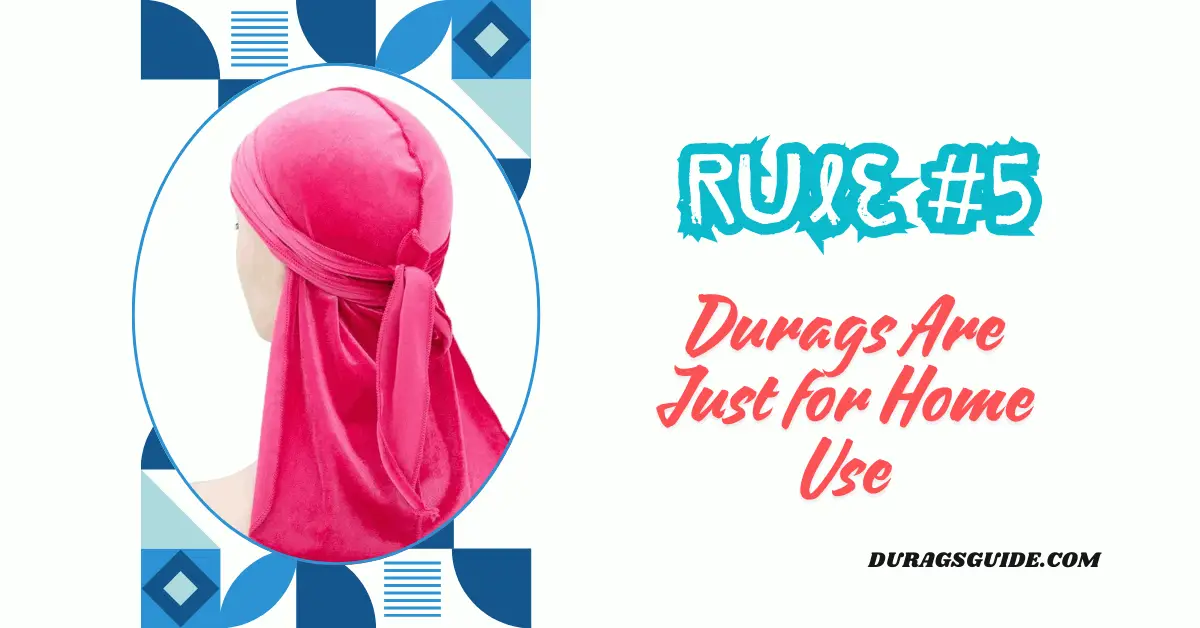
Rule #6: Durags Have a Solitary Standard Plan
A typical misinterpretation is that all durags appear to be identical, sticking to a solitary standard plan. Truly, durags arrive in a wide exhibit of styles, materials, and examples, mirroring their flexibility and the imagination of their wearers. This variety permits durags to be customized to different capabilities, designs, and individual inclinations.
Varieties in Plan, Material, and Style After some time
The fundamental plan of a durag regularly incorporates a piece of material with long tails that are tied at the rear of the head, getting the durag set up. Be that as it may, inside this fundamental system, there is huge variety.
1.Materials: Durags are produced using various materials, each offering various advantages. Normal materials include:
- Silk and Silk: These are well known for their smooth surface, which forestalls hair breakage and keep up with dampness. Silk and glossy silk durags are frequently utilized for hair care, especially for keeping up with waves and meshes.
- Velvet: Velvet durags have turned into an elegant decision because of their sumptuous appearance and delicate feel. They are frequently worn for style as opposed to only for hair upkeep.
- Cotton and Polyester: These materials are tough and breathable, making them reasonable for regular wear and athletic exercises. They give a harmony among usefulness and solace.
- Designs and Examples: The stylish allure of durags has prompted a large number of plans and examples.
- Strong Varieties: Exemplary strong variety durags are flexible and can be coordinated with different outfits. Dark, white, and essential tones are staples in this classification.
- Examples and Prints: From cover and botanical to mathematical and unique plans, designed durags consider individual articulation. These plans take care of various preferences and style.
- Embellishments: Some durags include extra embellishments like weaving, rhinestones, and logos. These enlivening components can add a novel touch, making the durag stand apart as a design proclamation.
- Functional Varieties: Durags are additionally intended to address explicit issues.
- Cooling Durags: Produced using dampness wicking materials, these durags are intended to keep the wearer cool during proactive tasks. They are well known among competitors and those taking part in open air exercises.
- Pressure Durags: These deal additional snugness and are frequently utilized for accomplishing and keeping up with waves. The pressure guarantees that the hair lays level and trains it into the ideal example.
- Convertible Durags: Highlighting flexible lashes and ties, convertible durags can be styled in more than one way, offering adaptability by they way they are worn.
Development and Customization in Current Durags
The advancement of durags is driven by development and the longing for customization. This has prompted new plans and uses, extending the job of durags past conventional assumptions.
- High-Style Durags: Architects have integrated durags into high-design assortments, trying different things with extravagance materials and vanguard plans. These durags are in many cases seen on runways and in design publications, featuring their status as an upscale embellishment.
- Custom Durags: Customization choices have become progressively well known, permitting people to plan their own durags. This can incorporate choosing explicit materials, tones, and examples, as well as adding individual contacts like monograms or logos. Custom durags are frequently utilized for exceptional occasions, special purposes, and as remarkable design explanations.
- Cultural and Themed Durags: Reflecting social legacy and subjects, some durags are planned with explicit social images, public banners, or themed designs. These plans celebrate personality and can be worn during far-reaching developments and festivities.
- Collaborations and Restricted Releases: Joint efforts between design brands, famous people, and craftsmen have created restricted version durags that are profoundly pursued. These restrictive plans frequently highlight special fine art and are delivered in little amounts, adding to their attractiveness.

Rule #7: Durags Are Only a Style
While durags have without a doubt turned into a style staple, lessening them to just a pattern disregards their significant social, social, and verifiable importance. Durags convey profound importance inside African American people group and then some, representing character, legacy, opposition, and pride.
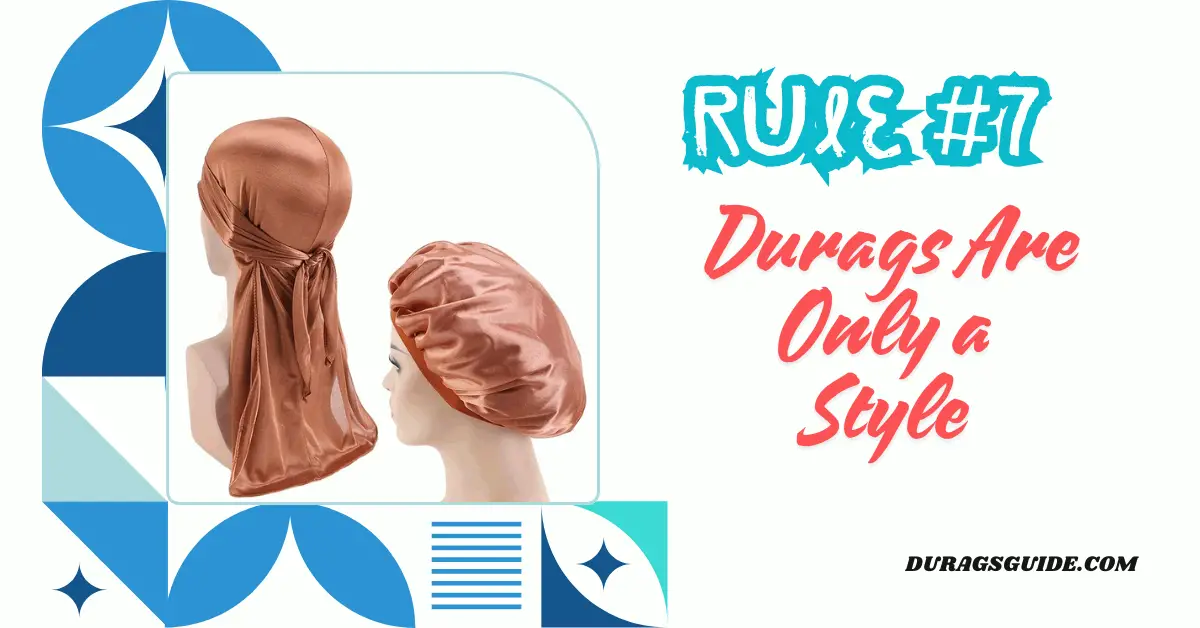
Social Meaning of Durags
Durags are significant of African American culture and character. By and large, they have been utilized as a device for hair care, especially in the support of waves, meshes, and different hairdos normal in the African American people group. This down to earth capability, nonetheless, is entwined with social pride and legacy.
During the Harlem Renaissance in the mid twentieth hundred years, durags turned out to be more apparent as African Americans tried to communicate their social character through style, music, and workmanship. The headwear was not just about hair support; it was an image of social articulation and pride in African roots.
The Social equality Development of the 1960s further solidified the durag’s importance. Activists and local area pioneers frequently wore durags as images of rebellion and fortitude. The Dark Power development saw the durag as a token of opposition against mistreatment and a festival of dark magnificence and culture.
In contemporary society, durags keep on being a strong image of personality. For the vast majority African Americans, wearing a durag is a demonstration of recovering social legacy and declaring pride in their regular hair and customary hairdos. It challenges standard excellence norms and advances acknowledgment and festivity of dark hair.
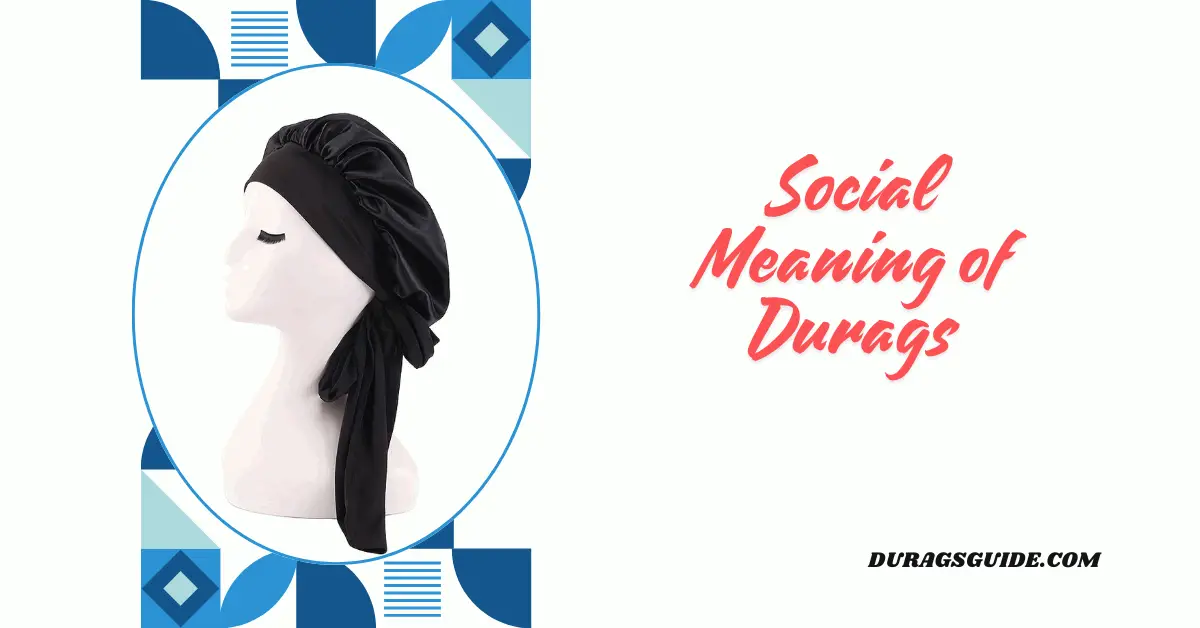
Durags in Friendly and Political Settings
Durags play likewise had an impact in friendly and political developments. They have been utilized to offer expressions about race, character, and opposition. For example, during the 1990s and 2000s, hip-bounce culture embraced the durag, with craftsmen wearing them as images of metropolitan flexibility and social pride. This public perceivability standardized the durag and related it with strength and singularity.
The People of color Matter development has seen activists wearing durags during fights and public appearances, supporting their job as images of fortitude and opposition. By wearing durags, activists honor their legacy and say something about racial fairness and equity. This cutting edge use highlights the durag’s getting through pertinence as a device for social editorial and political articulation.
The Durag as an Instrument for Strengthening
Past design and imagery, durags have turned into an instrument for strengthening. The normal hair development, which urges individuals to embrace their regular hair surfaces, has featured the significance of durags in keeping up with and safeguarding regular hairdos. This development has enabled people to dismiss destructive magnificence norms and embrace their regular excellence.
Durags likewise encourage a feeling of local area and shared personality. Online stages and web-based entertainment have made spaces where individuals share tips, styles, and encounters connected with durags. These people group praise the durag as a component of a more extensive social legacy and offer help and fellowship among their individuals.
Moreover, the customization and personalization of durags have permitted people to communicate their extraordinary characters. From weaved names to explicit varieties and examples that connote individual or social importance, modified durags empower wearers to offer individual and significant expressions.
The Getting through Effect of Durags
The effect of durags reaches out past their stylish allure. They act as a scaffold between ages, connecting contemporary design to verifiable and social roots. The proceeded with prevalence of durags among youngsters guarantees that their social importance will persevere, advancing with new implications and styles.
Durags likewise impact more extensive style, rousing creators and design fans around the world. Their joining into high style and established press features their adaptability and social reverberation. This perceivability instructs and illuminate individuals about the rich history and meaning of durags, encouraging more noteworthy appreciation and regard.
The Fate of Durags in Culture and Design
As we plan ahead, the durag’s impact gives no indications of fading. Its proceeded with presence in design, media, and social developments guarantees its getting through pertinence and effect. In addition, as society turns out to be more comprehensive and various, durags will keep on filling in as images of social pride and articulation for individuals, all things considered.
The advancement of durags reflects more extensive changes in mentalities toward magnificence, character, and portrayal. They challenge ordinary magnificence principles and praise the variety of hairdos and social customs. In that capacity, durags engage people to truly embrace their remarkable personalities and put themselves out there.
In the steadily changing scene of design and culture, durags stay a consistent sign of versatility, imagination, and social legacy. By embracing and reconsidering the durag story, we honor its heritage while preparing for new translations and articulations. The durag’s process is not even close to finished, and its future vows to be essentially as unique and significant as its past.

Final thoughts
All in all, the excursion through the seven standards about when durags were designed has disclosed a rich embroidery of social, social, and verifiable importance. Durags, a long way from being simple style embellishments or hair care devices, encapsulate strength, character, and pride. Testing normal confusions has permitted us to see the value in the assorted jobs and implications of durags across time and societies. As we rethink the durag story, we honor its inheritance while embracing its future as an image of strengthening and social articulation. Whether worn for useful purposes or as a striking design proclamation, durags stand as a demonstration of the getting through effect of social legacy and the steadily developing nature of character.
FAQS
When were durags invented?
Durags date back to the 19th century and were originally worn by African American women after the Civil War. They became popularized in the 1960s and 1970s as a cultural symbol among African American men.
Who was the first person to wear a durag?
The first person to wear a durag is not specifically documented, but durags have roots in the 19th century, worn by African American women post-Civil War. They became more widely recognized in the 1960s and 1970s.
What are the points of durags?
Durags are worn to maintain and protect hairstyles, such as waves and braids, and to keep hair neat and compressed. They also serve as a cultural symbol and fashion statement within the African American community.
Why do kids wear durags?
Kids wear durags to protect and maintain their hairstyles, like waves and braids, and to express cultural identity and style.
When were durags first invented?
Durags originated in the 19th century.
Who initially wore durags?
Initially, African American women wore durags post-Civil War.
When did durags become popular among men?
Durags gained popularity among men in the 1960s and 1970s.
Why did people originally wear durags?
Originally, durags were worn to protect and maintain hairstyles.
How did durags become a fashion statement?
Durags became a fashion statement through their association with hip-hop culture and as a symbol of cultural identity.
